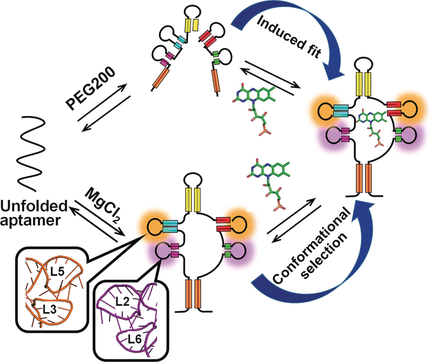Crowding Shifts the FMN Recognition Mechanism of Riboswitch Aptamer from Conformational Selection to Induced Fit
Graphical Abstract
How the FMN riboswitch aptamer recognizes anionic FMN in the presence of molecular crowding agent without Mg2+ ion, which mimics conditions in pathogenic bacterial cells, was investigated. Structural, kinetic, and thermodynamic analyses under crowding conditions reveal that FMN binding occurs through an induced fit mechanism. This is in contrast to the known conformational selection mechanism that occurs in the presence of Mg2+.
Abstract
In bacteria, the binding between the riboswitch aptamer domain and ligand is regulated by environmental cues, such as low Mg2+ in macrophages during pathogenesis to ensure spatiotemporal expression of virulence genes. Binding was investigated between the flavin mononucleotide (FMN) riboswitch aptamer and its anionic ligand in the presence of molecular crowding agent without Mg2+ ion, which mimics pathogenic conditions. Structural, kinetic, and thermodynamic analyses under the crowding revealed more dynamic conformational rearrangements of the FMN riboswitch aptamer compared to dilute Mg2+-containing solution. It is hypothesized that under crowding conditions FMN binds through an induced fit mechanism in contrast to the conformational selection mechanism previously demonstrated in dilute Mg2+solution. Since these two mechanisms involve different conformational intermediates and rate constants, these findings have practical significance in areas such as drug design and RNA engineering.





